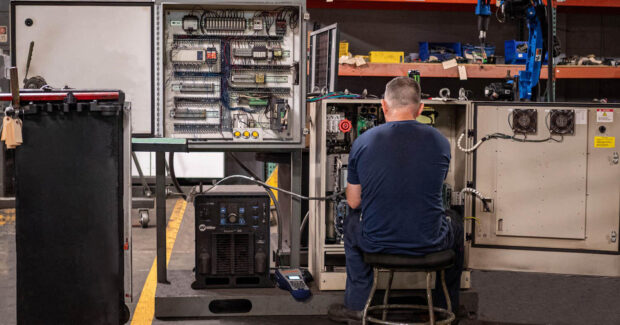How to Prepare Your CNC Machines and Robots for Optimal Performance Post-Shutdown
Effectively planning a post-shutdown maintenance procedure and power up program will ensure a smooth transition from maintenance to production.
Posted: January 20, 2025
In previous industrial maintenance roles, I would colloquialize Benjamin Franklin’s tagline “If you fail to plan, you plan to fail.” It goes without saying, we are as good as our process. We oftentimes spend countless hours fine tuning our machines and programs to then find a brief event took out the machine. We pride ourselves in cases of having SRAM backups to restore our parameters and part programs mitigating downtime. However, we overlook issues in our shutdown framework, and sometimes we forget to order new batteries for the servo modules, thus, negligently losing reference return positions. Worse yet, we spent hours of cleaning during shutdown maintenance to finally realize we accidentally jiggled wire terminations loose causing hotspots in our cabinets that lead to drive failure.
Post-shutdown procedures and checklists are paramount in our shutdown processes. When dealing with maintenance and production on a large scale, we would consider this part of a Process Failure Mode and Effects Analysis, or PFMEA for short. It is a fancy way of saying, think of all the things that could go wrong, and plan for the opposite with a special planning and execution team.
Before planning shutdown maintenance activities, perform a few steps to lessen downtime. Always keep consumable material inventory levels proportionate to upcoming needs. For instance, make sure to have SRAM batteries, fans, relays, and fuses, etc. on hand just in case. Allocate an appropriate amount of time to think about items you have seen fail in your plant or shop during normal operations and how failure likelihood could increase by a shutdown. Weigh this against ordering lead time to create an effective critical spare parts program. Create a power on checklist to ensure high-rate failure items are functioning properly, then create an action plan to execute if they do. Make sure to have all procedures on hand to reset reference return positions, reload backups, or realign tool changers and axes.
The Effects of Shutdown on CNC Machines and Robots
Problems with machine tools and robots love rearing up their heads after being powered down.
Common post-shutdown issues:
- Improper shut down or data saving procedures
*Software glitches and Windows system errors.
*SRAM or FROM parity errors. - Not properly changing SRAM and APC batteries
*Lost machine position data or CNC parameters.
*Non documented memory restoration process or no backups on file. - Electrical components
*Robot pendant cable strained, broken and shorted out.
*Stuck relays and contactors.
*Blown servo module fuses, transistor modules or IPMs.
*Loose wire terminations or broken connectors and terminals, loose DC Link.
*Inoperable cooling fans on servo/spindle modules. - Electrical cabinet thermoelectric coolers
*Inadequate refrigerant charge.
*Parameter or setting changes. - Damaged way covers
*Walking or standing on to perform maintenance.
*Manually moving or removing them. - The pneumatic system
*Contamination in lines and filter/regulators or scale purge circuit.
*Improper setpoints for pressure and flow.
*Push-to-connect fittings snapped off or cracked.
*Pinched lines or traveling axes yanking out of place.
Post-shutdown maintenance is a bit different than just performing shutdown maintenance.
Depending on the shutdown method at your facility, you might utilize some of this maintenance time to update servo software, realign machine axes, or teach some new points in the robot cell before the lights go out. This opens the need for pre-production verification whether these items were executed accurately, or in some cases, at all.
Before releasing machinery to production, consider the following:
- Check for coolant leaks during a test program.
- Verify the pneumatic system is clean, with functioning air dryers, and proper pressure/flow setpoints.
- Secure robot pendant cabling away from foot traffic and material handling.
- Follow manufacturer guidelines for powering up/down machines and ensure backups fully transfer before removing media to avoid data corruption.
- Inspect and secure DC link connections to prevent alarms or voltage issues; use IR thermography for verification.
- Ensure way covers and bellows are properly attached and free from damage or misalignment.
- Confirm software updates are completed if performed.
- Inspect robot cables and end-of-arm tooling for twists or wear; check hydraulic hoses for abrasion.
- Perform I/O checks to confirm sensor and system functionality.
- Reset parameter write settings, relays, and ladder editing to defaults.
- Complete alignments and calibrations before running production; avoid shortcuts.
- Power on auxiliary equipment and verify settings are unchanged.
Oftentimes, manufacturers wonder why post-shutdown checks are critical or even needed if regular preventative maintenance is conducted. When we shut down a machine to close a facility, we tend to perform deeper maintenance tasks on a machine tool or robot due to modern production demands. These weightier tasks tend to cause alignment changes in axes or positions, higher chances for leaks, and overlooked component connections due to the amount of work. It happens to the best of us, even with proper planning. Therefore, we should assemble a dedicated group to decide what gets completed on scheduled shutdowns, and what to do when we restore power.
Post-shutdown maintenance can be perfected with checklists, preplanning for possible failures and documentation. If mistakes happen, record it to improve upon your PFMEA. It is important to train your teams in effectively planning a post-shutdown maintenance procedure and power up program to ensure a smooth transition from maintenance to production. Also, in an event that something gets overlooked from the checklist, technicians need to know how to recover.















